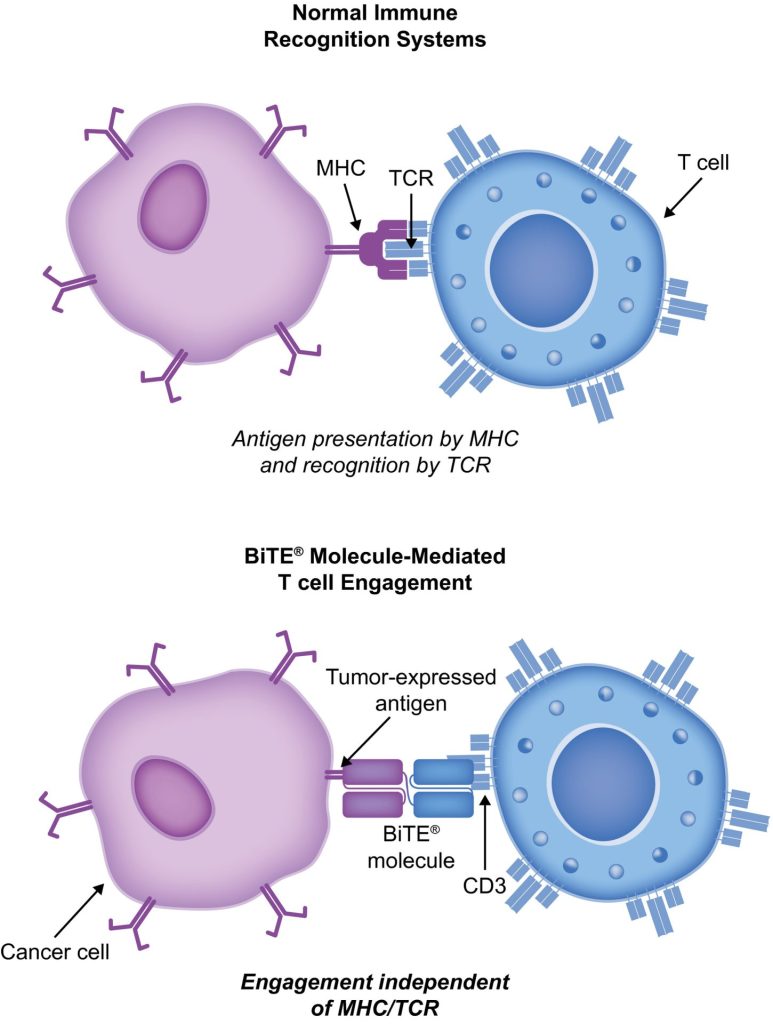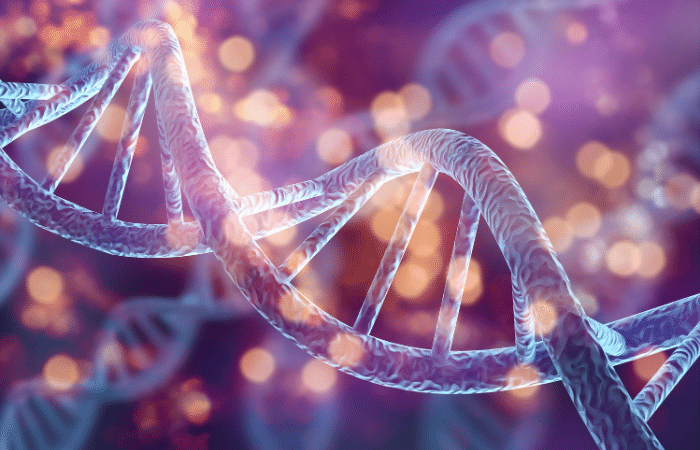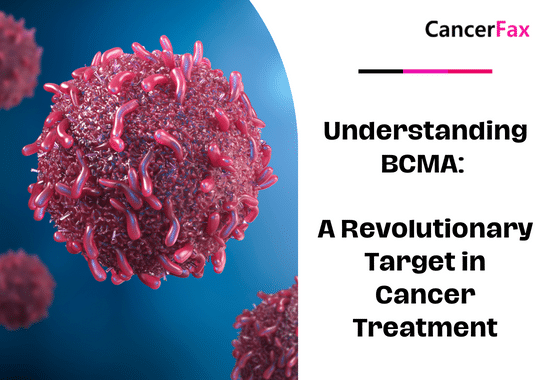Immuno-oncology is a way to treat cancer by using the body’s immune system. BiTE (bispecific T-cell engager) technology is a targeted immuno-oncology platform that binds a patient’s own T cells to cancer cells. Because BiTE technology is flexible, it is easy to make molecules that attack tumor-specific antigens, which makes immuno-oncotherapy possible. Blinatumomab was the first standard BiTE molecule to be approved. It targets CD19 surface antigens on B cells and is mostly unaffected by genetic changes or escape mechanisms inside cells. More BiTE molecules are being made to treat other blood cancers (like multiple myeloma, acute myeloid leukaemia, and B-cell lymphoma ທີ່ບໍ່ແມ່ນ Hodgkin) and solid tumours (like prostate cancer, glioblastoma, stomach cancer, and small-cell lung cancer). BiTE molecules that have a longer half-life than the standard ones are also being made. With BiTE technology, advances in immuno-oncology could make it easier to treat both blood and solid tumours and make them more effective when used with other treatments.
ການປິ່ນປົວດ້ວຍ BiTe ແມ່ນຫຍັງ?
Immuno-oncology therapies are scientifically proven ways to treat different types of solid and ມະເລັງໃນເລືອດ. Hematologic cancers are a good fit for treatments that target the immune system because cancerous blood cells move around with immune cells. Several immunotherapy ການປິ່ນປົວມະເຮັງແມ່ນຢູ່ໃນການເຮັດວຽກ.
Monoclonal antibody checkpoint inhibitors that stop the binding of checkpoint proteins (like PD-1 and CTLA-4) are useful against many types of cancer. They work well and are safe for many solid tumours, especially when they target PD-1. Non-small-cell lung, kidney, and bladder cancers have all been treated successfully with these drugs. But many people don’t react to checkpoint inhibitors or get sick again after taking them. Except for non-Hodgkin ເນື້ອງອກ, most results on hematologic cancers have been disappointing, especially for myeloma and leukaemia, where the overall response rate in approved indications ranges from 12.0% to 48.5%.8-15.
Other immuno-oncology treatments, on the other hand, have a higher success rate. Chimeric antigen-receptor (CAR) T-cell therapies change a patient’s T cells to attack a specific cellular antigen, such as CD19 in the treatment of B-cell malignancies and B-cell maturation antigen (BCMA) in the treatment of myeloma ຫຼາຍ (MM). CAR T-cell treatments have shown promise in treating hematologic cancers. They haven’t been as effective in treating solid tumours, but there have been some good results with neuroblastoma, human epidermal growth factor receptor tumours, and non-small-cell lung cancer. The genetic modification and in vitro multiplication of T cells take a long and complicated manufacturing process. This is a downside of this therapy because it makes it harder for patients to get this treatment quickly and in large numbers. The fact that lymphodepletion through chemotherapy preparation must be done first as a requirement for improved effectiveness is also a drawback.
ການປິ່ນປົວດ້ວຍ BiTE (bispecific T-cell engager) ເຊື່ອມຕໍ່ T cells ຂອງຄົນເຈັບກັບ antigens ສະແດງອອກຂອງ tumor. ນີ້ເຮັດໃຫ້ຄວາມສາມາດ cytotoxic ຂອງຈຸລັງ T ຂອງຄົນເຈັບເອງຂ້າມະເຮັງໂດຍບໍ່ມີການປ່ຽນແປງພັນທຸກໍາຂອງຈຸລັງ T ຫຼືຕ້ອງການການຂະຫຍາຍຕົວຫຼື manipulated ໃຫ້ເຂົາເຈົ້າຢູ່ນອກຮ່າງກາຍ. ໂມເລກຸນ BiTE ສາມາດຖືກນໍາໃຊ້ຢ່າງດຽວເປັນຢາຫຼືກັບການປິ່ນປົວອື່ນໆເພື່ອເຮັດໃຫ້ພວກມັນມີປະສິດທິພາບຫຼາຍຂຶ້ນ.
ກົນໄກການປະຕິບັດ BiT
BiTE molecules are antibody constructs with two binding domains. One recognises tumor-expressed antigens (such as BCMA, CD19, or -like protein [DLL3]), and the other, CD3, recognises T cells (Fig. 1). Two single-chain variable fragment (scFv) regions from monoclonal antibodies are connected by a flexible peptide linker to make the binding domains. The first scFv binding region can be changed to target any surface antigen, so it can be used right away to treat a wide range of tumours and can be used again later. The second scFv binding region always binds to CD3, which is a part of the T-cell receptor complex that never changes. When a BiTE molecule interacts with both a cytotoxic T cell and a tumour cell, the T cells begin to multiply. This increases the amount of effector cells and makes BiTE therapy more effective. Then, the death of cancer cells is started. BiTE molecules can get any T cells to do this because they don’t need co-stimulation or the usual processes of the major histocompatibility complex.

Blinatumomab is the first and only BiTE therapy that has been approved. It targets the CD19 receptor on both normal and cancerous B cells. It is a highly potent molecule with cytotoxic effects seen at low exposures (10–100 pg/mL)26. In its presence, T cells can perform serial-target lysis, quickly binding to and killing many cells. This is how BiTE therapies work, and it can be seen in other BiTE molecules that are still in research. In ມະເຮັງ lymphoblastic leukemia ສ້ວຍແຫຼມ (ALL), blinatumomab has been shown to be effective and safe. In 2014, the US Food and Drug Administration gave it fast approval, and in 2017, it got full approval for relapsed or refractory (R/R) B-cell precursor (BCP) ALL. In 2018, accelerated approval was given to Blinatumomab for treating BCP-ALL with minimum residual disease (MRD). This was the first approval for this use. In November 2015, the European Medicines Agency also gave it a green light for BCP-ALL with a Philadelphia chromosome (Ph) that is negative and R/R. Blinatumomab is approved for R/R BCP-ALL in adults and children in 57 countries, including Japan, all countries in the European Union, Canada, and Australia.
Blinatumomab ສໍາລັບການປິ່ນປົວຄົນເຈັບທີ່ມີ BCP-ALL
Blinatumomab ໄດ້ປ່ຽນວິທີການປິ່ນປົວ BCP-ALL. ເມື່ອປຽບທຽບກັບການປິ່ນປົວດ້ວຍຢາເຄມີແບບມາດຕະຖານ (SOC), ມັນໄດ້ເພີ່ມການຢູ່ລອດໂດຍລວມ (OS) ແລະຫຼຸດລົງຈໍານວນຂອງຜົນຂ້າງຄຽງບາງຢ່າງ (AEs). ການສຶກສາທີ່ສໍາຄັນຈໍານວນຫນຶ່ງ, ລວມທັງການທົດລອງຄວບຄຸມແບບສຸ່ມ, ໄດ້ສະແດງໃຫ້ເຫັນວ່າ blinatumomab ແມ່ນປອດໄພແລະໃຊ້ໄດ້ສໍາລັບ BCP-ALL ໃນຜູ້ໃຫຍ່ແລະເດັກນ້ອຍ. ການປິ່ນປົວດ້ວຍ T-cell, ມີພຽງແຕ່ຂໍ້ມູນຈາກ 2 ການສຶກສາກ່ຽວກັບແຂນດຽວ (clinicaltrials.gov IDs NCT01626495 ແລະ NCT01029366) ໃນນັ້ນເດັກນ້ອຍ 25 ຄົນ (ອາຍຸ 5-22 ປີ) ແລະ 5 ຜູ້ໃຫຍ່ (ອາຍຸ 26-60 ປີ) ທີ່ມີ R/R BCP-ALL ແລະ T-cell ALL ໄດ້ຮັບການປິ່ນປົວ. ແຕ່ຜົນໄດ້ຮັບແມ່ນມີຄວາມມຸ່ງຫວັງ (ການຕອບສະຫນອງຢ່າງເຕັມທີ່ [CR] ໃນ 90%, ການໃຫ້ອະໄພແບບຍືນຍົງກັບການຢູ່ລອດທີ່ບໍ່ມີເຫດການ 6 ເດືອນໃນ 67%, ແລະການຢູ່ລອດໂດຍລວມ [OS] ອັດຕາ 78% [ຕິດຕາມປານກາງ, 7 ເດືອນ; ຊ່ວງ, 1-24 ເດືອນ]).
ການສຶກສາຂອງ TOWER (A Phase 3, Randomized, Open Label Study Investigacy the BiTE Antibody Blinatumomab Versus Standard of Care Chemotherapy in Adult Subjects With Relapsed/Refractory B-Precursor ALL; clinicaltrials.gov identifier NCT02013167 ປຽບທຽບກັບຜົນກະທົບຂອງ monotherapy precursor ຂອງ monotherapy) ປິ່ນປົວຜູ້ໃຫຍ່ທີ່ມີ Ph-negative, R/R BCP-ALL. ເນື່ອງຈາກວ່າປະຊາຊົນມີອາຍຸຍືນ, ການສຶກສາໄດ້ຖືກຢຸດເຊົາໄວ. AEs ໃນກຸ່ມ blinatumomab ແມ່ນຄືກັນກັບທີ່ເຫັນໃນການສຶກສາກ່ອນຫນ້າ, ແລະ Blinatumomab ມີອັດຕາ AE ທີ່ຖືກປັບຕ່ໍາກວ່າ SOC.34 Blinatumomab ຍັງໃຊ້ໄດ້ສໍາລັບຜູ້ທີ່ມີ Ph-positive, R/R BCP-ALL ແລະສໍາລັບເດັກນ້ອຍທີ່ມີ Ph-negative, R/R BCP-ALL.
30% to 50% of people with BCP-ALL in complete hematologic remission show persistent MRD. In the single-arm, phase 2 BLAST study (A Confirmatory Multicenter, Single-Arm Study to Assess the Efficacy, Safety, and Tolerability of the BiTE Antibody Blinatumomab in Adult Patients With MRD of B-Precursor Acute Lymphoblastic Leukaemia; clinicaltrials.gov identifier NCT01207388), blinatumomab was tested on patients with BCP-ALL in first or later complete After blinatumomab treatment, 78% of patients who were MRD positive became MRD negative. The 5-year OS study showed a median OS of 36.5 months, and more than half of those who had a complete MRD response after the first cycle of blinatumomab were still alive at 5 years, which suggests that the treatment might be able to cure some patients. AEs were seen that were linked to ໂຣກການປ່ອຍ cytokine (CRS).31 Other studies, like NCT03023878 and NCT03340766, are still looking at blinatumomab in first-line settings and in combination with other treatments.
CD19-targeted treatments have been linked to failure because of the loss of CD19 antigen after treatment. The failure rates for blinatumomab range from 8% to 35%, and for CAR ການປິ່ນປົວ T-cell, they range from 39% to 65%.36-40 We don’t fully understand what causes therapy to fail, but one possibility is immunoediting, in which antigen loss is caused by a T-cell-dependent process called immunoselection, which lets tumour cells get away.41 Lineage switch and epitope loss under therapy pressure have also been suggested as ways for tumours to escape treatment. However, a recent study on epitope loss found that some CD19 isoforms that help CAR T-cells escape were already present at the time of diagnosis. This suggests that combining treatments might be helpful. Another thing that can cause immunotherapy to fail is called “inhibitory T-cell signalling.” In this case, the blocking programmed death ligand-1 (PD-L1) is interesting because it is more common in B-cell ALL cells from patients who don’t respond to blinatumomab and can make CD3 BiTE molecules less effective.43 By making a CD28/PD-L1 BiTE that triggers the CD28 co-stimulatory signal instead of the inhibitory signaling pathway that is usually seen when a T cell binds to a PD-L1-expressing cancer cell, this inhibition could be turned off.43 Dual-targeted CAR T cells are also being looked into as a way to make up for the loss of tumour antigens. This can be done by modifying each T cell with 2 CAR molecules and 2 different binding domains (dual-signaling CAR) or by putting 2 different binding domains on 1 CAR molecule at the same time (TanCAR).
ເຫດການທີ່ບໍ່ດີກັບ BiTE ແລະການຈັດການຂອງມັນ
ໃນການສຶກສາທາງດ້ານຄລີນິກຂອງ blinatumomab, AEs ທົ່ວໄປທີ່ສຸດແມ່ນອາການໄຂ້, ຈໍານວນເມັດເລືອດຂາວຕ່ໍາ, ແລະຈໍານວນ platelet ຕ່ໍາ. ບາງຄວາມສ່ຽງທີ່ສໍາຄັນທີ່ສຸດແມ່ນ CRS, neurotoxicity, ແລະຄວາມຜິດພາດຂອງຢາເສບຕິດ. ຄວາມເປັນພິດທາງ neurotoxicity ຍັງສາມາດເກີດຂຶ້ນກັບ CD19 ສະເພາະ CAR T-cell ການປິ່ນປົວ, ແຕ່ມັນອາດຈະບໍ່ແມ່ນຍ້ອນ CD19. ຜົນໄດ້ຮັບຂອງການສຶກສາໄລຍະ 1/1b ທີ່ຍັງດໍາເນີນຢູ່ກ່ຽວກັບເປົ້າຫມາຍ CD20/CD3 ສະແດງໃຫ້ເຫັນວ່າ CNS AEs ຂອງຊັ້ນຮຽນທີ 3 ຫຼືສູງກວ່າແມ່ນຫາຍາກ (3% ຂອງ AE ຊັ້ນຮຽນທີ 3 ທັງໝົດ). ສ່ວນຫຼາຍແລ້ວ, ປະຕິກິລິຍາຂອງ blinatumomab ກັບ CRS ແມ່ນອ່ອນໆ, ແຕ່ໃນກໍລະນີທີ່ຫາຍາກ, ມັນສາມາດເປັນຮ້າຍແຮງແລະເຖິງແມ່ນໄພຂົ່ມຂູ່ຕໍ່ຊີວິດ. ປະຕິກິລິຍາອັກເສບສາມາດຫຼຸດລົງດ້ວຍ corticosteroids. ເພື່ອຫຼຸດໂອກາດຂອງ CRS, ມັນດີທີ່ສຸດທີ່ຈະໃຫ້ຢາ prednisone ຫຼື dexamethasone ້ໍາຕົ້ມກ່ອນຢາ blinatumomab ຄັ້ງທໍາອິດແລະເພີ່ມປະລິມານຢ່າງຊ້າໆ. ການໃຊ້ corticosteroids ນີ້ກ່ອນທີ່ໂມເລກຸນ BiTE ອື່ນໆໄດ້ໃຫ້ເຫດຜົນທີ່ຈະໃຊ້ dexamethasone ເປັນຢາ premedication ເມື່ອໃຊ້ໂມເລກຸນ BiTE ອື່ນໆ. ຢ່າງໃດກໍ່ຕາມ, ມັນບໍ່ຊັດເຈນວ່າຜົນກະທົບນີ້ສາມາດຖືກນໍາໃຊ້ກັບແພລະຕະຟອມ BiTE ທັງຫມົດ, ແລະວິທີການອື່ນໆເພື່ອຈັດການກັບ CRS ກໍາລັງຖືກພິຈາລະນາ. Interleukin 6 ແມ່ນ cytokine ທີ່ເຮັດໃຫ້ເກີດ CRS ແລະສູງໃນຜູ້ທີ່ມີມັນ. Tocilizumab, ເຊິ່ງຕັນ interleukin-6 receptor, ໄດ້ຖືກນໍາໃຊ້ເພື່ອປິ່ນປົວ CRS ທີ່ບໍ່ດີຫຼາຍຫຼັງຈາກການປິ່ນປົວ CAR T-cell.49 ໃນໂຮງຫມໍ, tumor necrosis factor- inhibitors ຍັງຖືກນໍາໃຊ້ເພື່ອປິ່ນປົວ CRS.


